Green modular wall
The first modular wall was built in the 1930s and was designed by American Professor White, who called the individual modules of the green wall botanical bricks. Modular “green bricks” could be properly put together and built from them spatial objects.
Modern modular wall systems are much more complex than gabion green wall systems. The entire structure consists of three essential elements:
– the structure on which the modules – attached to the vertical surface – e.g. the wall of the building are mounted,
– modules filled with soil substrates in which plants grow, attached to the prepared structure,
– automatic irrigation system, which connects all the modules of the structure into a network – nourishes and irrigates plants greening the wall.
The modules are made of lightweight materials (e.g. plastics) and assembled from several parts, on the sides of the modules there are locking systems which allow them to be joined together, attached to a vertical or horizontal frame.
The substrate used for filling the modules must be: light, adapted to the species composition of the greening plants of the module and to the existing environmental conditions under which the green wall is located. [5] The soil substrate mixture should contain appropriate compositions of organic and non-organic compounds and elements of light substrate (porous mineral granules, coconut fibres, etc.) [6]
The selection of plants depends on the environmental conditions in a given location of the “vertical garden” and its exposure to the directions of the world. Plants can be evergreen or dump leaves for the winter. [7]
The whole system must be connected to the automatic irrigation system is a heavy construction, so it is important to consult its placement on a given wall with the building builder (both in the case of professionally made structures and performed amateurly by private users).
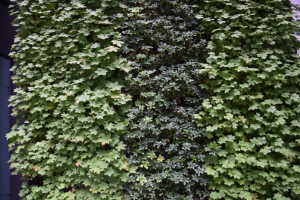
An example of the selection of vegetation for greening modular walls.

For professionals.
– Modular systems are designed and set up by specialized companies involved in the installation of such systems. As with green roofs, it is important to protect the walls very accurately from possible moisture.
Examples of construction solutions by company – gsky.
https://gsky.com/pro/cad-specs/
For society:
Although modular walls are complex systems, you can also make these types of structures on your own.
1) We need to carefully protect the wall from possible moisture, e.g. pvc film, or make free-standing structures on which we will place the modules made by us.
2) We mount structures to such a secured wall, on which green modules will be attached. (It is important not to pierce the done insulation.)
3) Modules can be made from store boxes, where, for example, bread is transported to the shops every morning.

http://www.lushe.com.au/2010/05/03/living-wall-at-changi-airport/
Large store boxes can be divided, thanks to specially prepared compartments into smaller parts, which will allow us, for example, to diversify the species used to green the module.
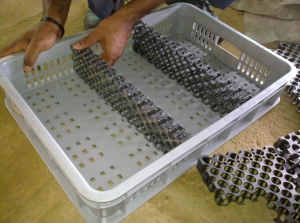
http://www.lushe.com.au/2010/05/03/living-wall-at-changi-airport/
The whole is taught, for example, geo-fibrous to protect the soil substrate from spilling out of the box.
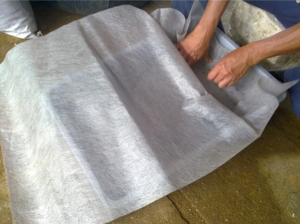
We fill the box with a prepared soil substrate.We fill the box with a prepared soil substrate.
http://www.lushe.com.au/2010/05/03/living-wall-at-changi-airport/
We fill the box with a prepared soil substrate.
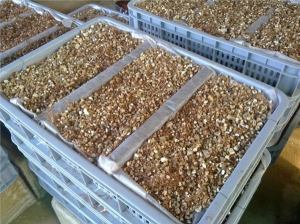
http://www.lushe.com.au/2010/05/03/living-wall-at-changi-airport/
We secure the whole thing with a grid in which we make holes, which will allow us to green the boxes.
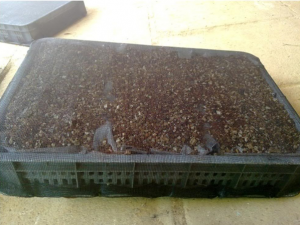
http://www.lushe.com.au/2010/05/03/living-wall-at-changi-airport/

http://www.lushe.com.au/2010/05/03/living-wall-at-changi-airport/
We mount the handles to the boxes, which will make it capacity to attach them to the previously prepared frame. All modules can be connected to an automatic irrigation system. Excess water should be collected into a container, trough and used for watering other plants.
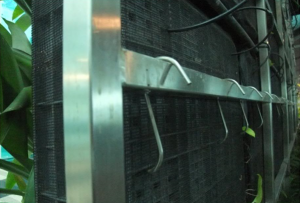
http://www.lushe.com.au/2010/05/03/living-wall-at-changi-airport/
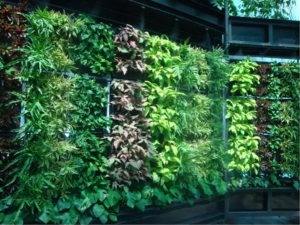
http://www.lushe.com.au/2010/05/03/living-wall-at-changi-airport/
Building at the Foundation for Polish Science in Warsaw.
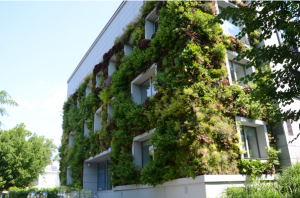
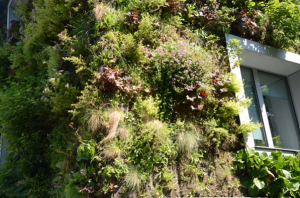
Green façade on the building of the “Foundation for Polish Science” – has an area of 260 m2. The whole structure does not weigh more than 30 kg m2. This “Vertical Garden” is at the same time an insulating layer of the building, it is greened by 20 species of plants – the species have been selected in this way to make the wall attractive throughout the growing season. The plants are irrigated with rainwater stored on the roof of the building. The property is located in Warsaw at Ignacy Krasicki Street 20/22.
Building of the city hall in Wroclaw.
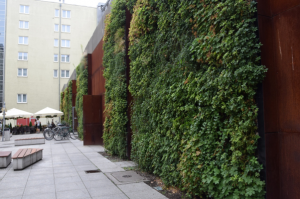
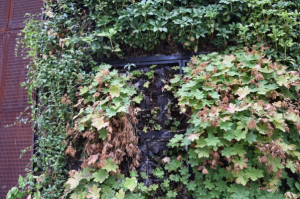
I am located on the façade of the city building of the Wrocław City Hall on Świdnicka Street in Wroclaw. It has an area of 100 m2.
